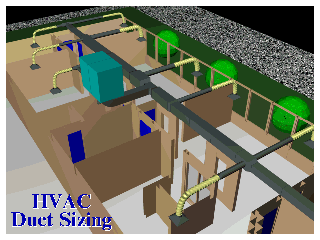Commercial HVAC Load Software Taking Big Steps Forward©
by Bill Smith, president of Elite Software

 Software for commercial hvac projects covers a broad range of applications. Hvac load calculations, equipment selection, operating cost analysis, drawing production, specifications, controls design and implementation are just some of the applications aided by software on
commercial hvac projects.
Software for commercial hvac projects covers a broad range of applications. Hvac load calculations, equipment selection, operating cost analysis, drawing production, specifications, controls design and implementation are just some of the applications aided by software on
commercial hvac projects.
 Some of these tasks can be handled by non-hvac software. For example, hvac and mechanical specification writing has long been automated with the use of word processing software. Most spec writers simply modify a standard specification document as needed for each project. In some instances, hvac equipment selection software will also create documents and reports that aid in specification writing.
Some of these tasks can be handled by non-hvac software. For example, hvac and mechanical specification writing has long been automated with the use of word processing software. Most spec writers simply modify a standard specification document as needed for each project. In some instances, hvac equipment selection software will also create documents and reports that aid in specification writing.
In the case of hvac system drawings,  CAD (computer aided drafting) software greatly aids the creation of these drawings. Of course, most CAD packages must be supplemented with drawing aid software in order to create hvac specific drawings. It's interesting to note that basic CAD systems are really just sophisticated tools to draw lines, arcs, and circles. They
generally don't have built-in commands to draw hvac specific items. To make a CAD package draw duct work or an air handler, you need special symbols and mechanical details to accomplish this. Fortunately, most CAD vendors offer these hvac drawing accessories at a reasonable price. Some air conditioning manufacturers also provide hvac drawing aid software.
CAD (computer aided drafting) software greatly aids the creation of these drawings. Of course, most CAD packages must be supplemented with drawing aid software in order to create hvac specific drawings. It's interesting to note that basic CAD systems are really just sophisticated tools to draw lines, arcs, and circles. They
generally don't have built-in commands to draw hvac specific items. To make a CAD package draw duct work or an air handler, you need special symbols and mechanical details to accomplish this. Fortunately, most CAD vendors offer these hvac drawing accessories at a reasonable price. Some air conditioning manufacturers also provide hvac drawing aid software.
Nowadays, almost all commercial hvac installations use some kind of a control system. Even with the advent of the BACNET control standards there is still a great deal of manufacturer specific programming and configuration that must be done to implement a modern hvac controls system. Because of the uniqueness of each control manufacturer's equipment there is not generic software available to design and model an hvac control system. Every control
manufacturer supplies software tools to help perform the system design and installation, but the designer still has to learn a great deal of manufacturer specific information.
Easier than learning manufacturer specific controls software is equipment selection software. Whether you are selecting a pump, coil, or a chiller, most manufacturers can now supply you with software to make equipment selection fast and easy. Basically, the intent of selection software is to automate the process of weeding through all the tables and charts of a
product catalog. Of course, each manufacturer has its own software and particular way of doing things so you can't get around having to learn scores of different selection programs. But still, learning to use all those selection programs is much easier than learning each manufacturer's manual catalog selection procedure.
The one hvac design task that must be done before any of the above can be started is hvac load calculations. For example, you can't use equipment selection software until you know the maximum heating and cooling loads in btus per hour that the hvac equipment must deliver. You can't use a CAD package to draw double line ductwork until you know the air quantities you
are going to supply to each room. Likewise, control systems design and specification writing can't be completed until the basic load calculations are done and equipment is selected.
Unlike equipment selection software, hvac load calculation software does not have to be manufacturer specific. Even the hvac manufacturers that offer load calculation software acknowledge that load calc software can be used to size any hvac equipment. Since load calc software is generic and the hvac designer does not have to change the software used for every project, designers can afford more consideration in the selection of load calc software.

Most commercial hvac load calculation programs are still DOS based at this time. The complexity of the application and the relatively small specialized market for this type of program accounts for the lag in Windows based load calc software. However, that situation is rapidly changing as a number of the traditional suppliers of commercial load calc software will
offer new Windows versions this fall.
As with any application, Windows brings many basic benefits to load calc software and takes it to an entirely new level of power and unctionality. Simultaneous views of multiple data screens, point and click data entry, hypertext help information, numerous colorful graphics, and presentation quality reports are typical features of any Windows program. Windows based load calc programs get these important features plus many more unique to hvac applications.
Special uses of Windows capabilities in load calc programs include graphic "tree" representations of project data and colorful hvac icons for toolbar buttons for intuitive program operation. Another is the ability to share data with other hvac related programs such as for duct sizing, operating cost analysis, or even sales proposal generators. Linking with Windows equipment databases from ARI and GAMA is yet another benefit gained from a Windows based load calc program.
As more hvac specific software is released in Windows it will be hard to tell where one program ends and another begins. There will be tremendous sharing of data amongst programs. The concept of a vendor specific "suite" of programs may become obsolete as programs from numerous different vendors will be expected to work together and share data as needed. For example, there may come a time when an hvac load calc program won't have any market value
unless it can read building data and dimensions from a CAD drawing from one vendor and export output data to yet another vendor's program for equipment selection.
Besides putting a "pretty face" on software and creating many new data sharing possibilities, the most immediate benefit of Windows based hvac software comes from increased productivity through greater ease of use. New hvac designers and older ones who are not so familiar with computers will find it much easier to pick up and learn Windows based hvac software. Good thing too, since virtually every design task performed by hvac professionals is
now being computerized. If you prefer using your mind for dreaming up new and better hvac systems, then new Windows hvac software that relieves you of lots of calculation drudgery is sure to be a welcome sight.
 Mr. Smith welcomes your email about this article. - email
Mr. Smith welcomes your email about this article. - email
Copyright ©
Elite Software Development, Inc., webmaster@elitesoft.com
 Software for commercial hvac projects covers a broad range of applications. Hvac load calculations, equipment selection, operating cost analysis, drawing production, specifications, controls design and implementation are just some of the applications aided by software on
commercial hvac projects.
Software for commercial hvac projects covers a broad range of applications. Hvac load calculations, equipment selection, operating cost analysis, drawing production, specifications, controls design and implementation are just some of the applications aided by software on
commercial hvac projects. CAD (computer aided drafting) software greatly aids the creation of these drawings. Of course, most CAD packages must be supplemented with drawing aid software in order to create hvac specific drawings. It's interesting to note that basic CAD systems are really just sophisticated tools to draw lines, arcs, and circles. They
generally don't have built-in commands to draw hvac specific items. To make a CAD package draw duct work or an air handler, you need special symbols and mechanical details to accomplish this. Fortunately, most CAD vendors offer these hvac drawing accessories at a reasonable price. Some air conditioning manufacturers also provide hvac drawing aid software.
CAD (computer aided drafting) software greatly aids the creation of these drawings. Of course, most CAD packages must be supplemented with drawing aid software in order to create hvac specific drawings. It's interesting to note that basic CAD systems are really just sophisticated tools to draw lines, arcs, and circles. They
generally don't have built-in commands to draw hvac specific items. To make a CAD package draw duct work or an air handler, you need special symbols and mechanical details to accomplish this. Fortunately, most CAD vendors offer these hvac drawing accessories at a reasonable price. Some air conditioning manufacturers also provide hvac drawing aid software.